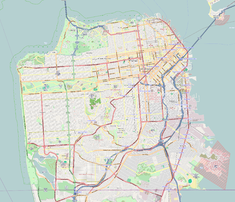|
Third Baptist Church (San Francisco, California)
The Third Baptist Church, formerly the First Colored Baptist Church, is an American Baptist church founded in 1852, and located in the Western Addition neighborhood of San Francisco, California.[2][3] It is the city of San Francisco's oldest African-American church.[4][5] The church occupied several spaces in San Francisco over the course of its history. Since 1976, Rev. Amos C. Brown has been the pastor.[6] It is affiliated with the American Baptist Churches USA. The Third Baptist Church Complex is listed as a San Francisco Designated Landmark since November 15, 2017.[1] HistoryIn August 1852, the First Colored Baptist Church congregation was founded in the house of Eliza and William Davis, by Black parishioners including the Davis family, Abraham Brown, Thomas Bundy, Harry Fields, Thomas Davenport, Willie Denton, George Lewis, and Fielding Spotts.[7][8] Prior to 1852, African American Baptist parishioners attended the primarily-white First Baptist Church, and were forced to sit in the balcony.[5] Other African American churches founded in 1852 in San Francisco included Bethel African Methodist Episcopal Church (Bethel AME Church), and African Methodist Episcopal Zion Church (AME Zion Church).[9] The first location of the church building was founded in 1852 at the corner Grant Avenue and Greenwich Street in San Francisco.[7][9] The former Grant Avenue location is listed as a California Historical Landmark (Number 1010) since February 16, 1993.[10] In 1854, the church was moved to Dupont Street at Greenwich Street, the location was the former First Baptist Church.[4] A year later in 1855, the church was renamed as the Third Baptist Church with the name legally changed in 1908.[7] From 1921 until 1972, the church operated the Madame C.J. Walker Home for Girls and Women, a charitable, community and social services organization for single African American woman new to San Francisco, who were not eligible to use the YWCA.[11][12] The church building at 1399 McAllister Street was designed by architect William F. Gunnison and completed in 1952.[1] In 1958, W. E. B. Du Bois spoke to the church congregation.[5] Pastors
Notable membersSee also
References
External links |
||||||||||||||||||||||||||


